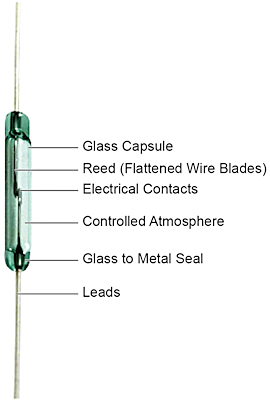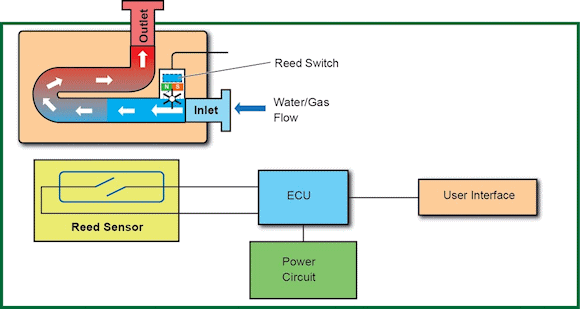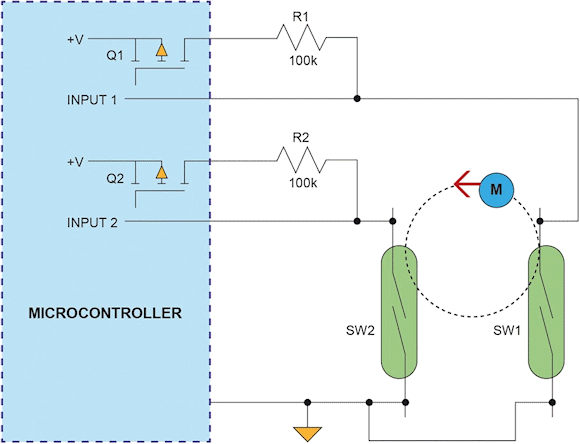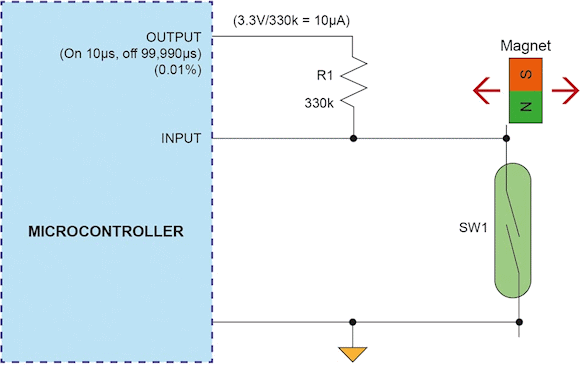
Introduction
When it comes to low-power metering applications such as water and gas meters, some design engineers feel that state-of-the-art solutions are the best way to tackle position-sensing challenges. Opting for the latest and greatest technologies, they may choose solid-state magnetoresistive (MR) or Hall effect sensors for their sensitivity, durability, and reliability.
While these innovative technologies offer some advantages, they pale in comparison to the proven benefits of reed switch technology. For decades, reed switches have been used for low-power, battery-operated applications, and for good reason.
This article explores the top five advantages of this technology, including its low operating power, tight power usage tolerance, precise magnetic sensitivity switchpoints, and inherent switchpoint hysteresis. In addition, reed switches allow for the simple customization of sensitivities and other application-specific requirements. Increased worldwide demand for reed switch technology and its use in a variety of applications validate the technology's pivotal position in the sensing and controls market.
Low-Power Metering Application Requirements
Gas and water meters fit with automatic meter reading (AMR) systems require sensors that use very little power. Water and gas usage is often measured by a magnet attached to a rotating shaft. Each revolution is converted to an electrical signal and accumulated by an embedded controller.
Low power consumption is a critical design parameter in these systems. Furthermore, the expected lifetime of these meters is typically 20 years without battery replacement. Therefore, conservation of battery power is critical to extending the usable lifetime of the power source.
Solid-State Sensing Technologies
As mentioned, some design engineers select solid-state sensing technologies, including MR and Hall effect sensors, for low-power metering applications. MR sensors are monolithic integrated circuit devices with built-in resistive elements paired with complementary metal-oxide semiconductor (CMOS) circuitry. When exposed to a magnetic field, the electrical resistance of the MR device changes in relation to the direction of the magnetic field. This change in resistance can be used to detect the change in an applied magnetic field. An MR sensor can perform as a non-contact switch with very low current consumption, high sensitivity, and reliability. However, typical MR sensors continuously draw a small amount of current.
Hall effect sensors are semiconductor-based transducers that vary the output voltage in response to changes in the magnetic field. These sensors combine a Hall sensing element with circuitry to provide a digital on/off function that corresponds to the change of a magnetic field without involving any moving parts.
Like MR sensors, Hall effect sensors continuously draw a small amount of current. MR and Hall effect sensors are not ideal for many low-power, battery-operated applications because they do not meet the strict requirements for accuracy and power.
Reed Switch Technology
Although considered a mature technology, the reed switch has remained a popular choice for low-power applications because of its simplicity and reliable performance. A reed switch is an electrical switch operated by an applied magnetic field. The switch consists of two or three thin metal pieces called reeds, with plated contacts at their tips that are spaced a small distance apart.
The reeds are typically enclosed in a sealed glass tube filled with inert gas. A field from a magnet or an electromagnet deflects the reeds, making or breaking the switch contacts. Figure 1 shows the various components of a reed switch.

Fig. 1: Components of a reed switch
Figure 2 illustrates the position of the reed switch in the flow detection portion of a water or gas meter.

Fig. 2: Reed switch used as a flow measurement instrument for a water or gas meter
The Five Advantages of Reed Switch Technology
1. Low operating power
Reed switches require much lower power than MR and Hall effect sensors. These micro-power sensing technologies achieve low power by using a low duty cycle of active sensing, which requires a constant draw of current to run an internal oscillator.
In contrast, reed switches are passive components that do not require any power to operate. One low-power reed switch configuration involves using two reed switches in combination with field-effect transistor (FET) switches (see fig. 3). The reed switches can be designed to sense rotating motion with truly zero power, except when one of the switches detects movement.

Fig. 3: Two reed switches used in combination with FET switches
In figure 3, M = magnet; SW1 and 2 = reed switches. When SW1 is closed, SW2 is open. Q1 is turned off to prevent power consumption. When SW2 closes, the microcontroller wakes up, turns Q2 off, turns Q1 on, and goes back to sleep. A similar sequence of events occurs when SW1 closes.
Alternatively, a microcontroller already in the system can poll a reed switch contact at a rate of 10 Hz for an average current draw of about 10 µs/100 ms x 10 µA = 1 nA.

Fig. 4: Ultra low power achieved with polling
Reed switches offer a much lower power consumption than any other competing technology could deliver, saving significant cost by reducing battery size requirements. In power-sensitive applications, reed switches are the best solution for maximizing power efficiency.
2. Tight power usage tolerance
Solid-state devices have a typical operating current and a maximum operating current. Good design practices consider worst-case values. The larger maximum currents of solid-state sensing devices can be an issue if they require more current draw from the batteries and reduce the product's lifetime.
In contrast, the current draw of a reed switch is set by a resistor and the power supply rail. Typical power supply and resistor tolerances for reed switches are much tighter than solid-state device specifications for operating current.
For example, a micro-power Hall effect sensor may have a typical average operating current of 5 µA, but a worst-case average operating current of 10 µA. A nanopower MR sensor may have a typical average operating current of 310 nA (0.31 µA), but a worst-case average operating current of 6350 nA (6.35 µA).
In comparison, a continuously operating reed switch circuit, which is closed half the time and operates with a 1-M? pull-up resistor and a 3V power supply, will have a typical average operating current of 1.5 µA. It will also have a worst-case average operating current of 1.66 µA. This assumes that power supply and resistor tolerances are 5%. In this example, the reed switch has the lowest worst-case power consumption even before using power-saving techniques like those described above.
3. Precise Magnetic Sensitivity Switchpoints
One important characteristic of a reed switch is its sensitivity or the amount of magnetic field necessary to actuate it. Reed switch sensitivity is measured in units of ampere-turns (AT) and corresponds to the current in a coil multiplied by the number of turns.
Typical pull-in (operating) sensitivities range from 8 to 40 AT. Although reed switch magnetic sensitivity is specified in units of AT, an approximate relationship states that 1 AT = 1 Gauss, which equals 0.1 milli-Tesla (mT).
The magnetic sensitivity switchpoints of reed switches are more precise than solid-state digital switches. High accuracy is especially important when designing the system to function under all operating conditions. For example, a reed switch may be specified for a sensitivity from 18 to 22 AT. This has a relative sensitivity range of (22 to 18)/20 = 20% or ±10%.
In comparison, a micro-power Hall effect sensor may have a sensitivity range of 25 to 55 Gauss (2.5 to 5.5 mT), with a resultant relative sensitivity range of 75% or ±37%. A nano-power MR sensor may have a sensitivity range of 6 to 20 Gauss (0.6 to 2.0 mT), with a resultant relative sensitivity range of 108% or ±54%.
4. Simple Customization
Common solid-state micro- and nano-power magnetic switches are made to be one-size-fits-all. These switches are usually available in one, two, or three wide (imprecise) sensitivity ranges. If the sensitivity or update rate does not meet an application's requirements, it is difficult to get a custom solution that offers tighter sensitivity ranges.
In contrast, reed switches are widely available in custom sensitivity ranges that can be tailored to the requirements of a specific application. For example, an application may need a sensitivity range of 8 to 11 AT, while another application may need 25 to 30 AT. This level of versatility is not available in solid-state magnetic sensing devices.
Additionally, reed switch customizations such as mechanical packaging and termination options are available to easily fit these sensors into a wide variety of applications. Reed switch contact options include normally open, normally closed, and single pole, double throw (SPDT).
Micro- and nano-power solid-state switches do not operate continuously. During the switch's sleep time, the magnetic field is not sensed and the output is not updated. If the sleep time is 100 ms, then the output is updated 10 times per second. If the magnet being sensed is moving too fast, then the sensor output will not be able to keep up and sensing errors will result. Reed switches do not sleep, so they can be used at speeds of hundreds of times per second.
5. Inherent Switchpoint Hysteresis
Relative to sensor technology, hysteresis is defined as the difference in the magnetic field level between the operate (output "on") point and the release (output "off") point of the device. Some amount of hysteresis is very important in metering applications where the movement being sensed can stop at any point in a rotary cycle. Without hysteresis, a very small change in the magnetic field could result in an unintended change in the output and a measurement error.
A small magnetic field change could be caused by nearby electrical currents, i.e., power lines, motors, etc., or by metal moving in earth's field. The strength of earth's magnetic field is 0.25 to 0.65 Gauss (0.025 to 0.065 mT). These uncontrolled magnetic fields limit both the minimum hysteresis required for a robust design and the useful sensitivity of the sensors. High magnetic sensitivity is useful for electronic compasses, but not for proximity sensors.
Minimum hysteresis is an important consideration in the design of a robust metering application. In solid-state magnetic sensors, hysteresis must be added to the sensing element using circuitry, which means that it will be fixed and difficult to control. In contrast, reed switches have inherent hysteresis due to their magneto-mechanical design, thereby delivering enhanced reliability to the metering application.
Position of Reed Switches in Sensing and Controls Market
Reed switches are a proven technology with a long track record. Their hermetically sealed contacts have contributed greatly to their use in many electronic applications. They provide reliable data without the need for physical contact, even in adverse environments containing dirt, vibration, moisture, gas, and oil. Their proven durability and reliability have made them a popular choice for several demanding applications including automotive safety products, medical equipment, security, utility metering, consumer electronics, and white goods/appliances.
Reed switches also offer an extended product life cycle. Because a reed switch only has internal components that bend and the electricity is completely contained in the reeds and lead wires, it does not have a failure mode related to mechanical wear. With some electrical loads, the operating life exceeds 50 years and one billion switching cycles. Worldwide demand for reed switch technology has continued to increase to over 1 billion each year. In response to this demand, manufacturers are making product improvements to reed switches to continue meeting the changing needs of the market.
Conclusion
When designing low-power metering applications, reed switch technology offers numerous benefits over solid-state sensing technologies. Its low operating power, tight power usage tolerance, precise magnetic sensitivity switchpoints, inherent switchpoint hysteresis, and simple customization make it a flexible, reliable technology.
Its hermetically sealed contacts and extended operating life make it an attractive option for numerous applications including those with hazardous conditions. With decades of proven performance, the application of and demand for reed switch technology continues to grow and expand along with rapid developments in electronics and mechatronics.
About the Author
Mark Pickhard is the lead engineer for sensors in the Electronic Business Unit at Littelfuse. Since joining Hamlin in 1987, he worked for the company until it was acquired by Littelfuse in 2013. Mr. Pickhard's responsibilities include reed switch and sensor design as well as collaboration with sales and marketing. He received his BSEE from the University of Wisconsin-Madison, has been active in the reed switch and sensor industry for 27 years, and holds three US patents.
Related Stories
Fluid Level Sensors – More Than Just an On/Off Signal
Magnetic Sensors Find Opportunities in Green Energy
Achieving the Potential of Sensors in Smart Meters